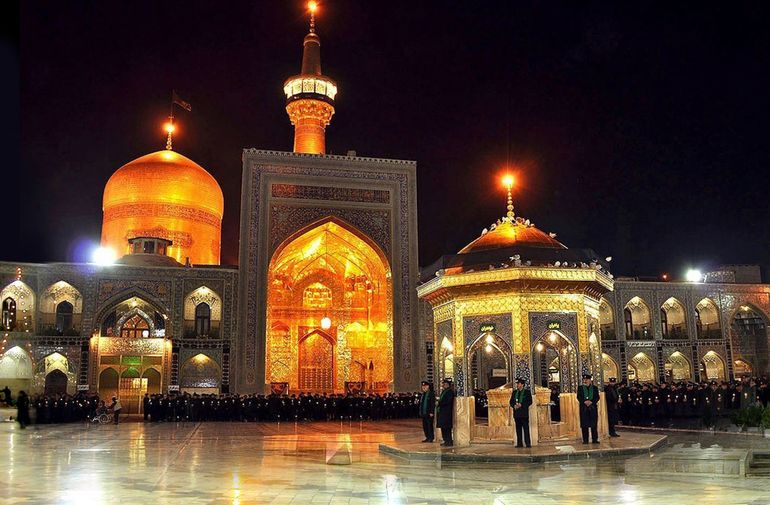The eighth Shia Imam, Ali ibn Musa Al-Ridha (AS), was born in Medina in 765 AD.

His parents were Imam Musa Al-Kadhim (AS) and Lady Tahira (SA) . He was given the epithet Al-Ridha (‘the one agreed upon’) and his teknonym was Abul-Hassan. After the martyrdom of his father in Baghdad, Imam Ridha (AS) became the Leader of Shia Muslims for twenty years; ten years under the reign of Harun Al-Rashid, five years under Amin and five years under Maʾmun. The Imam was martyred in 818 AD.
The tyranny imposed on the society by Umayyad and Abbasid rulers had given rise to popular sentiments that demanded the creation of a genuinely Islamic government under the leadership of someone from the Prophet’s household. The lofty position and high popularity of the Shia Imams (AS) had always made the Umayyad and Abbasid rulers incarcerate them so that people could not learn anything from them. The rulers feared that any connection between the Imams and people, as this threatened their grip on power.
After killing his own brother Amin, Maʾmun decided to bring the Shia Imam (AS) from Medina to his capital in Marv to better control him. Imam Al-Ridha (AS) was “invited” to Marv, but this was merely a pretence for imposing further restrictions on his activities.
In a bid to demonstrate to Muslims that this invitation was actually a form of exile, he went to Marv alone without any family members. In order to thwart Imam Al-Ridha’s (AS) efforts, Harun ordered a group of people, including the governor of Medina, to accompany him during his travel which took him from Medina to Basra, Khorramshahr, Ahvaz, Rey, Nishapur and, finally, Marv. The Imam (AS) arrived in Marv in 201 AH. In Nishapur, Imam Al-Ridha (AS) was warmly welcomed by people. He was entreated to narrate hadith to them. He related a Hadith Qudsi which he said dated back to the Prophet (PBUH):
“THE FORMULA ‘LA ILĀHA ILL ALLĀH’ IS MY FORTRESS. ANYONE WHO REPEATS IT ENTERS MY FORTRESS. WHOEVER IS INSIDE MY FORTRESS WILL BE PROTECTED FROM PUNISHMENT.”
The traditionalists who were present took a note of the Hadith expressed by the Imam (AS) being carried in Howdah. Minutes after, the Imam (AS) pushed the Howdah’s curtain aside and added: “It has conditions and I am one of these conditions”. He meant that monotheism will save people if they accept the governance of the Shia Imams (AS).
Two important issues in the Imam’s (AS) life
In Marv, Maʾmun and his courtiers made a show of respecting the Imam. The Caliph offered him two options; Maʾmun first insisted that Imam Al-Ridha (AS) should accept to become Caliph but the Imam (AS) refused. Then Maʾmun offered him to become successor-in-waiting, which the Imam accepted conditionally. Had the Imam (AS) accepted to become Caliph, Maʾmun would have recruited spies to keep an eye on him to prevent him from taking any reforming steps. In that case, the Imam (AS) could not undertake any action to awaken the people and he would have met the same fate as Imam Ali whose caliphate was consumed by unrest and civil war. In that case, the Imam (AS) would have been forced to surrender authority to Maʾmun who could then claim that his caliphate is legitimate.
Why did the Imam (AS) accept to become successor-in-waiting to Maʾmun?
Imam Al-Ridha (AS) accepted the post on condition that he would not be responsible for anything and that he would not appoint or dismiss anyone. In this way, the Imam (AS) wanted to show everyone that this post is just a formality.
Had the Imam not accepted the offer, he would have been threatened with death. In the case, the Imam would have been murdered without triggering any awakening in society. When the Imam (AS) first refused to become the successor-in-waiting, Maʾmun told him in clear terms that he had no option but to accept. (Irshād)
Imam Al-Ridha (AS) had told people that he was following Imam Ali (AS) who had accepted to be a part of Umar ibn Al-Khattab’s succession committee. (ʿUyūn Akhbār Al-Riḍā) When Rayyan ibn Al-Salat asked the Imam about his reasons for accepting the post, he said: “God is well aware that I did not want it. But I was facing two options of accepting to become his appointed successor or to be killed. I had to accept it.” (ʿUyūn Akhbār Al-Riḍā)
Imam Al-Ridha’s (AS) martyrdom
Even with him as his appointed successor, Maʾmun remained afraid of Imam Al-Ridha’s (AS) growing popularity. His fear increased when he saw the masses of people who attended the congregational prayers led by him. He poisoned the Imam but wanted to cover his plot up. After the news of the Imam’s death spread, he went quickly to the Imam’s (AS) house and started crying. Maʾmun heard from people there that he was one of suspects in the killing of Imam Al-Ridha (AS). Maʾmun, who feared incidents, ordered the funeral be postponed to the following day. When the crowds went away, religious ablutions were performed on the Imam before he was buried next to Harun Al-Rashid. (ʿUyūn Akhbār Al-Riḍā)
Source: Shīa Islam: History and Doctrines, Ayatullāh Jaʿfar Subḥānī, Chapter 29.
Source: en.shafaqna.com

